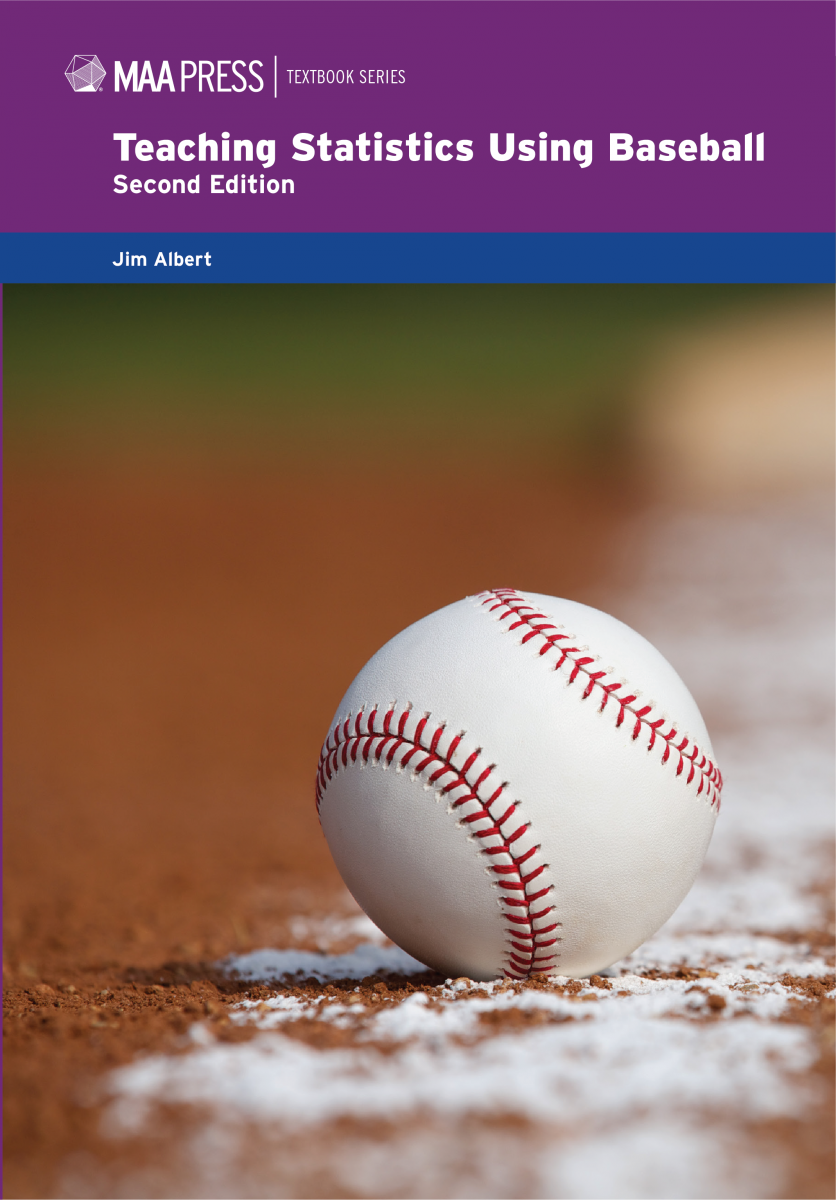- About MAA
- Membership
- MAA Publications
- Periodicals
- Blogs
- MAA Book Series
- MAA Press (an imprint of the AMS)
- MAA Notes
- MAA Reviews
- Mathematical Communication
- Information for Libraries
- Author Resources
- Advertise with MAA
- Meetings
- Competitions
- Programs
- Communities
- MAA Sections
- SIGMAA
- MAA Connect
- Students
- MAA Awards
- Awards Booklets
- Writing Awards
- Teaching Awards
- Service Awards
- Research Awards
- Lecture Awards
- Putnam Competition Individual and Team Winners
- D. E. Shaw Group AMC 8 Awards & Certificates
- Maryam Mirzakhani AMC 10 A Awards & Certificates
- Two Sigma AMC 10 B Awards & Certificates
- Jane Street AMC 12 A Awards & Certificates
- Akamai AMC 12 B Awards & Certificates
- High School Teachers
- News
You are here
Teaching Statistics Using Baseball

Second Edition
By Jim Albert
Print ISBN: 978-1-93951-216-1
Electronic ISBN: 978-1-61444-622-4
256 pp., Paperbound, 2017
List Price: $55.00
MAA Member: $41.25
Series: MAA Textbooks
There is an active effort by people in the baseball community to learn more about baseball performance and strategy by the use of statistics. This book illustrates basic methods of data analysis and probability models by means of baseball statistics collected on players and teams. Students often have difficulty learning statistical concepts since they are explained using examples that are foreign to the students. The idea of the book is to describe statistical thinking in a context (that is, baseball) that will be familiar and interesting to students.
The second edition of Teaching Statistics follows the same structure as the first edition, where the case studies and exercises have been replaced by modern players and teams, and the new types of baseball data from the PitchFX system and fangraphs.com are incorporated into the text.
About the Author
Jim Albert received a BS degree in mathematics from Bucknell University in 1975 and a PhD in statistics from Purdue University in 1979. He has taught at Bowling Green State University since 1979 and is currently a Professor of Mathematics and Statistics. His is a Fellow of the American Statistical Association. His research interest is in Bayesian inference and has published over 60 papers in refereed journals. In addition, he works in the areas of statistical education and applications of statistics in sports. He is currently editor of The American Statistician, the “general interest” journal published by The American Statistical Association (ASA). He has been active both in the Section of Bayseian Statistical Science and the Section on Statistics in Sports of the American Statistical Association. He has written four books: Bayesian Computation Using Minitab, Ordinal Data Modeling (with Val Johnson), Workshop Statistics: Discovery with Data, A Bayesian Approach (with Allan Rossman), and Curve Ball: Baseball, Statistics, and the Role of Chance in the Game (with Jay Bennett). The book Curve Ball has been reviewed favorably in many publications, including The Wall Street Journal, The Journal of the American Statistical Association, Physics Today, Technometrics, MAA Reviews, Tech Directions Magazine, Baseball American, Mathematics Magazine, SIAM News, and Science News. Curve Ball was a winner of the 2001 The Sporting News-SABR Baseball Research award, and was recently included in the “The Essential Sabermetric Library” in an article by Randy Klipstein in the Newsletter of the Statistical Analysis interest group of SABR (The Society of American Baseball Research).
MAA Review
I have been afflicted with a chronic condition that ensures that at least once each year, usually in August or September, I will feel miserable. I am a Cubs fan. This year, the annual attack came a month later than usual, but it was much stronger than in past years. As I was recovering, I was asked to review Teaching Statistics Using Baseball, by Jim Albert. Heeding the old saying that you can prove anything with statistics, I sought to cheer myself up by searching for some sort of vindication for my years spent rooting for the lovable losers from Chicago, beyond the affirming regularity with which I get to say, "Wait 'til next year!"
Well, I'm still looking for the vindication, but this is a delightful book. Albert has been applying his love of baseball to his vocation of teaching statistics for some time now, and this text uses baseball as a framework to introduce and explore statistical topics. He has created a window through which the statistically-minded baseball fan can explore, explain, and debunk conventional wisdom concerning the national pastime. Albert uses this text for an introductory statistics course focused on baseball, but it's far more valuable as a resource for non-trivial applications and projects for any introductory statistics course, and as a gift for that baseball fan in your department. Continued...
Tags:
Book Series:




